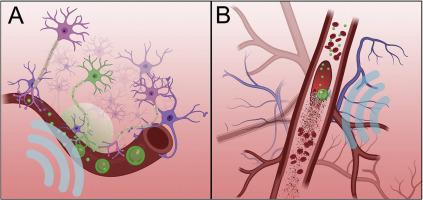Current Opinion in Colloid & Interface Science ( IF 8.9 ) Pub Date : 2021-08-23 , DOI: 10.1016/j.cocis.2021.101498 Phillip G. Durham 1 , Paul A. Dayton 1, 2

|
Phase change contrast agents (PCCAs) have been studied in the medical ultrasound field for nearly three decades. Their ability to convert from a liquid core droplet to an acoustically active microbubble has enhanced the possibilities of medical ultrasound, enabling new imaging approaches as well as therapeutic directions. However, traditional PCCAs are formulated with perfluorocarbons which are a liquid at standard temperature and pressure, requiring a high amount of energy to transition the encapsulated droplets to gas form, possibly resulting in undesired bioeffects. A new generation of low-boiling point PCCAs, which are formulated from gaseous perfluorocarbons in a metastable liquid state, seeks to overcome these limits. These super-heated liquid perfluorocarbon nanodroplets display longer circulation kinetics than microbubbles, their activation produces unique acoustic signatures, and their small particle size holds potential for extravascular applications. Low-boiling point nanodroplets can be phase-transitioned when activated with ultrasound at pressures and frequencies approved for diagnostic imaging. From the first publication almost 10 years ago, low-boiling point PCCA research has expanded rapidly, and recent advances in super-resolution imaging, drug delivery and neuromodulation made possible by these nanodroplets are just a few examples of this growing field of research. In this review, we discuss low-boiling point phase change contrast agents and their applications in ultrasound imaging and therapeutics.
中文翻译:

亚微米低沸点相变造影剂在超声成像和治疗中的应用
相变造影剂 (PCCA) 已在医学超声领域进行了近三年的研究。它们从液态核心液滴转化为声学活性微泡的能力增强了医学超声的可能性,实现了新的成像方法和治疗方向。然而,传统的 PCCA 是用全氟化碳配制的,全氟化碳在标准温度和压力下为液体,需要大量能量才能将封装的液滴转变为气体形式,可能会导致不希望的生物效应。新一代低沸点 PCCA 由亚稳态液态的气态全氟化碳配制而成,旨在克服这些限制。这些过热的液态全氟化碳纳米液滴显示出比微泡更长的循环动力学,它们的激活会产生独特的声学特征,并且它们的小粒径具有血管外应用的潜力。当在批准用于诊断成像的压力和频率下用超声波激活时,低沸点纳米液滴可以发生相变。从大约 10 年前的第一篇文章开始,低沸点 PCCA 研究迅速扩展,这些纳米液滴使超分辨率成像、药物输送和神经调节成为可能的最新进展只是这个不断发展的研究领域的几个例子。在这篇综述中,我们讨论了低沸点相变造影剂及其在超声成像和治疗中的应用。当在批准用于诊断成像的压力和频率下用超声波激活时,低沸点纳米液滴可以发生相变。从大约 10 年前的第一篇文章开始,低沸点 PCCA 研究迅速扩展,这些纳米液滴使超分辨率成像、药物输送和神经调节成为可能的最新进展只是这个不断发展的研究领域的几个例子。在这篇综述中,我们讨论了低沸点相变造影剂及其在超声成像和治疗中的应用。当在批准用于诊断成像的压力和频率下用超声波激活时,低沸点纳米液滴可以发生相变。从大约 10 年前的第一篇文章开始,低沸点 PCCA 研究迅速扩展,这些纳米液滴使超分辨率成像、药物输送和神经调节成为可能的最新进展只是这个不断发展的研究领域的几个例子。在这篇综述中,我们讨论了低沸点相变造影剂及其在超声成像和治疗中的应用。这些纳米液滴使药物递送和神经调节成为可能,这只是这个不断发展的研究领域的几个例子。在这篇综述中,我们讨论了低沸点相变造影剂及其在超声成像和治疗中的应用。这些纳米液滴使药物递送和神经调节成为可能,这只是这个不断发展的研究领域的几个例子。在这篇综述中,我们讨论了低沸点相变造影剂及其在超声成像和治疗中的应用。



























 京公网安备 11010802027423号
京公网安备 11010802027423号